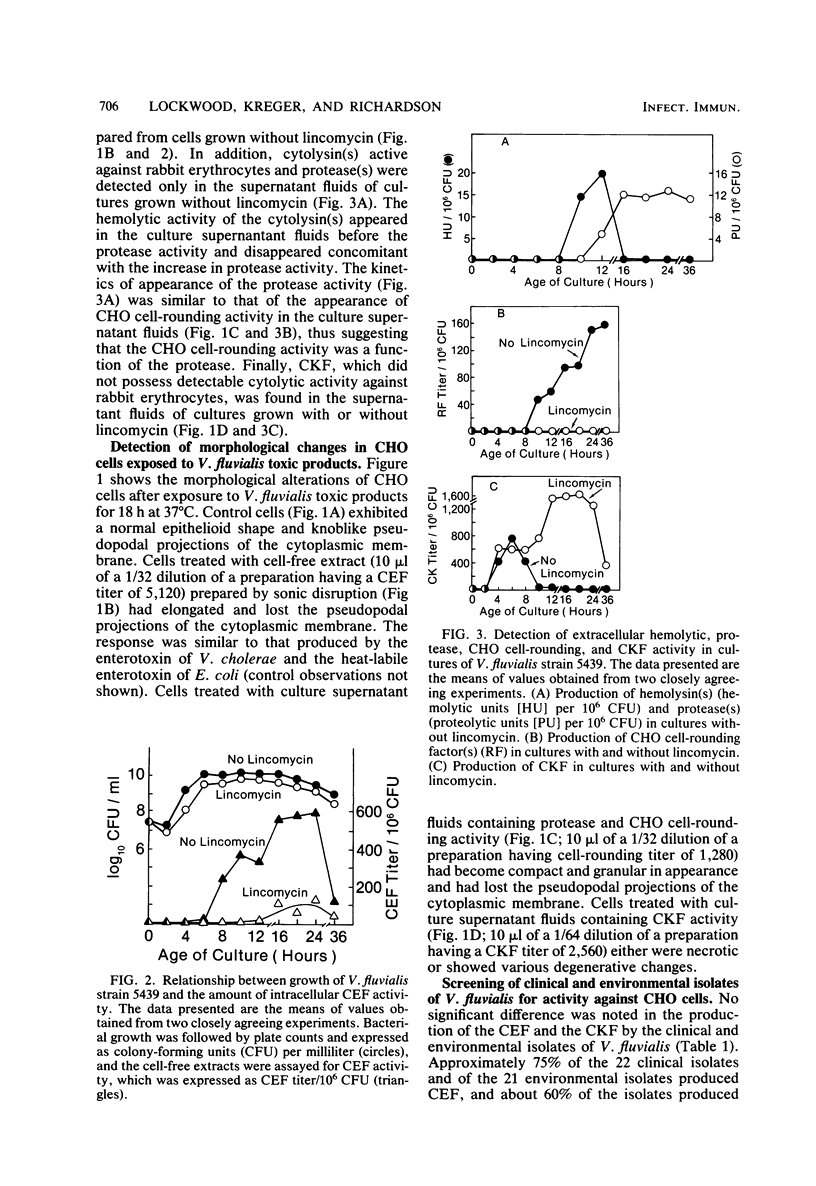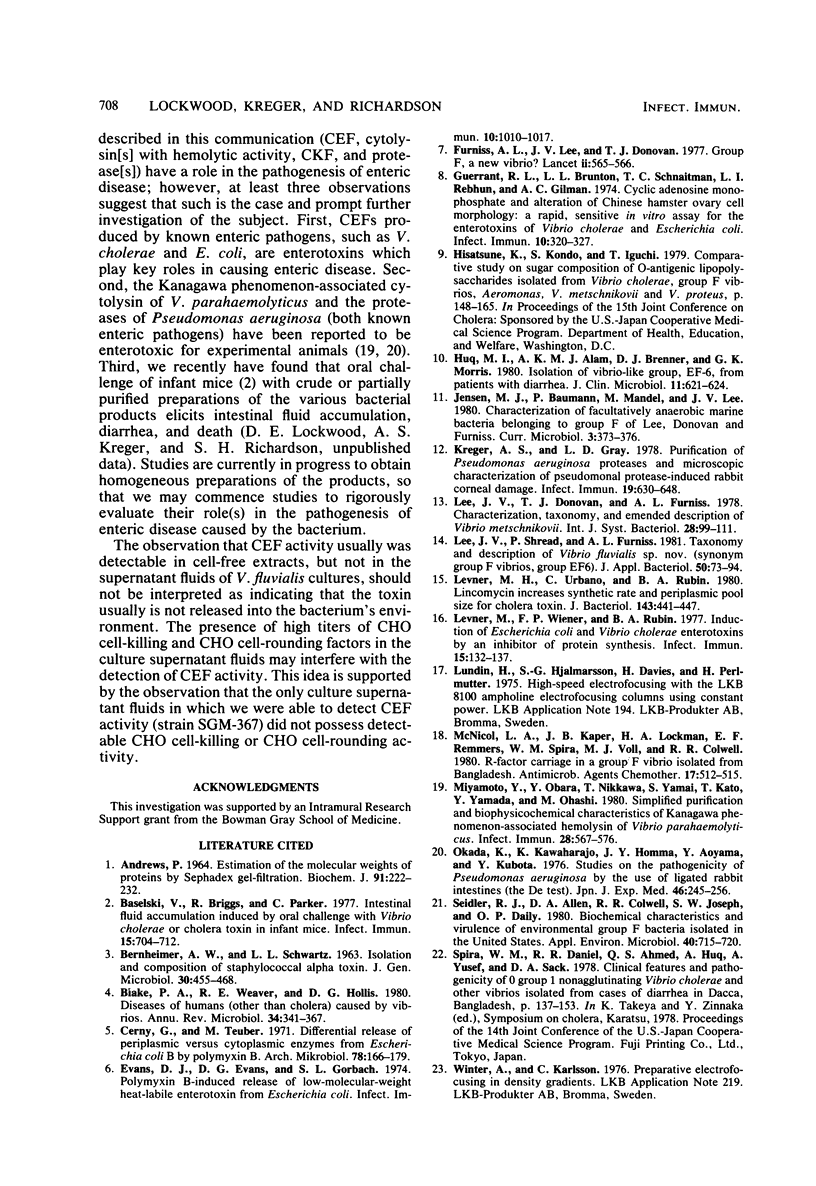Abstract
The results of studies with cell-free extracts and culture supernatant fluids of Vibrio fluvialis (a recently recognized, potential enteric pathogen for humans) grown in the absence and presence of lincomycin indicated that the bacterium could produce (i) a factor which causes CHO cell elongation (CEF) similar to that elicited by V. cholerae enterotoxin and by the heat-labile enterotoxin of Escherichia coli, (ii) cytolysin(s) active against erythrocytes, (iii) nonhemolytic, CHO cell-killing factor(s), and (iv) protease(s) active against azocasein. The CEF was heat labile and ammonium sulfate precipitable, and it had an isoelectric point (estimated by sucrose density gradient electrofocusing) and molecular weight (estimated by gel filtration) of about 5.1 and 135,000, respectively.
Full text
PDF






Images in this article
Selected References
These references are in PubMed. This may not be the complete list of references from this article.
- Andrews P. Estimation of the molecular weights of proteins by Sephadex gel-filtration. Biochem J. 1964 May;91(2):222–233. doi: 10.1042/bj0910222. [DOI] [PMC free article] [PubMed] [Google Scholar]
- BERNHEIMER A. W., SCHWARTZ L. L. Isolation and composition of staphylococcal alpha toxin. J Gen Microbiol. 1963 Mar;30:455–468. doi: 10.1099/00221287-30-3-455. [DOI] [PubMed] [Google Scholar]
- Baselski V., Briggs R., Parker C. Intestinal fluid accumulation induced by oral challenge with Vibrio cholerae or cholera toxin in infant mice. Infect Immun. 1977 Mar;15(3):704–712. doi: 10.1128/iai.15.3.704-712.1977. [DOI] [PMC free article] [PubMed] [Google Scholar]
- Blake P. A., Weaver R. E., Hollis D. G. Diseases of humans (other than cholera) caused by vibrios. Annu Rev Microbiol. 1980;34:341–367. doi: 10.1146/annurev.mi.34.100180.002013. [DOI] [PubMed] [Google Scholar]
- Cerny G., Teuber M. Differential release of periplasmic versus cytoplasmic enzymes from Escherichia coli B by polymixin B. Arch Mikrobiol. 1971;78(2):166–179. doi: 10.1007/BF00424873. [DOI] [PubMed] [Google Scholar]
- Evans D. J., Evans D. G., Gorbach S. L. Polymyxin B-Induced Release of Low-Molecular-Weight, Heat-Labile Enterotoxin from Escherichia coli. Infect Immun. 1974 Nov;10(5):1010–1017. doi: 10.1128/iai.10.5.1010-1017.1974. [DOI] [PMC free article] [PubMed] [Google Scholar]
- Furniss A. L., Lee J. V., Donovan T. J. Group F, a new Vibrio? Lancet. 1977 Sep 10;2(8037):565–566. doi: 10.1016/s0140-6736(77)90712-7. [DOI] [PubMed] [Google Scholar]
- Guerrant R. L., Brunton L. L., Schnaitman T. C., Rebhun L. I., Gilman A. G. Cyclic adenosine monophosphate and alteration of Chinese hamster ovary cell morphology: a rapid, sensitive in vitro assay for the enterotoxins of Vibrio cholerae and Escherichia coli. Infect Immun. 1974 Aug;10(2):320–327. doi: 10.1128/iai.10.2.320-327.1974. [DOI] [PMC free article] [PubMed] [Google Scholar]
- Huq M. I., Alam A. K., Brenner D. J., Morris G. K. Isolation of Vibrio-like group, EF-6, from patients with diarrhea. J Clin Microbiol. 1980 Jun;11(6):621–624. doi: 10.1128/jcm.11.6.621-624.1980. [DOI] [PMC free article] [PubMed] [Google Scholar]
- Kreger A. S., Gray L. D. Purification of Pseudomonas aeruginosa proteases and microscopic characterization of pseudomonal protease-induced rabbit corneal damage. Infect Immun. 1978 Feb;19(2):630–648. doi: 10.1128/iai.19.2.630-648.1978. [DOI] [PMC free article] [PubMed] [Google Scholar]
- Lee J. V., Shread P., Furniss A. L., Bryant T. N. Taxonomy and description of Vibrio fluvialis sp. nov. (synonym group F vibrios, group EF6). J Appl Bacteriol. 1981 Feb;50(1):73–94. doi: 10.1111/j.1365-2672.1981.tb00873.x. [DOI] [PubMed] [Google Scholar]
- Levner M. H., Urbano C., Rubin B. A. Lincomycin increases synthetic rate and periplasmic pool size for cholera toxin. J Bacteriol. 1980 Jul;143(1):441–447. doi: 10.1128/jb.143.1.441-447.1980. [DOI] [PMC free article] [PubMed] [Google Scholar]
- Levner M., Wiener F. P., Rubin B. A. Induction of Escherichia coli and Vibrio cholerae enterotoxins by an inhibitor of protein synthesis. Infect Immun. 1977 Jan;15(1):132–137. doi: 10.1128/iai.15.1.132-137.1977. [DOI] [PMC free article] [PubMed] [Google Scholar]
- McNicol L. A., Kaper J. B., Lockman H. A., Remmers E. F., Spira W. M., Colwell R. R. R-factor carriage in a group F vibrio isolated from Bangladesh. Antimicrob Agents Chemother. 1980 Mar;17(3):512–515. doi: 10.1128/aac.17.3.512. [DOI] [PMC free article] [PubMed] [Google Scholar]
- Miyamoto Y., Obara Y., Nikkawa T., Yamai S., Kato T., Yamada Y., Ohashi M. Simplified purification and biophysicochemical characteristics of Kanagawa phenomenon-associated hemolysin of Vibrio parahaemolyticus. Infect Immun. 1980 May;28(2):567–576. doi: 10.1128/iai.28.2.567-576.1980. [DOI] [PMC free article] [PubMed] [Google Scholar]
- Okada K., Kawaharajo K., Homma J. Y., Aoyama Y., Kubota Y. Studies on the pathogenicity of Pseudomonas aeruginosa by the use of ligated rabbit intestines (the De test). Jpn J Exp Med. 1976 Aug;46(4):245–256. [PubMed] [Google Scholar]
- Seidler R. J., Allen D. A., Colwell R. R., Joseph S. W., Daily O. P. Biochemical characteristics and virulence of environmental group F bacteria isolated in the United States. Appl Environ Microbiol. 1980 Oct;40(4):715–720. doi: 10.1128/aem.40.4.715-720.1980. [DOI] [PMC free article] [PubMed] [Google Scholar]



